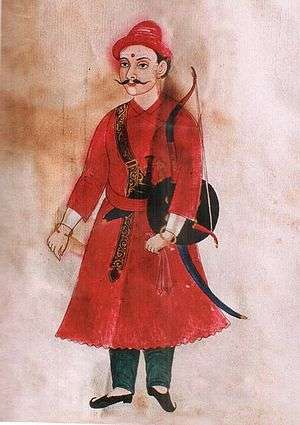Kirtiman Singh Basnyat
Kirtiman Singh Basnyat (Nepali: कीर्तिमान् सिंह बस्न्यात) was Mul Kaji (Chief Minister) of the Royal Court of Nepal between 1794 and his death on 28 September 1801. He was a military commander of the Nepalese Army.
Kirtiman Singh Basnyat | |
|---|---|
श्री मूलकाजी साहेब कीर्तिमान सिंह बस्न्यात | |
 Portrait of Mulkaji Kirtiman Singh Basnyat | |
| Mul (Chief) Kaji of Nepal | |
| In office 1794 – 28 September 1801 | |
| Preceded by | Abhiman Singh Basnyat |
| Succeeded by | Bakhtawar Singh Basnyat |
| Personal details | |
| Born | 1760 |
| Died | September 28, 1801 (aged 41) Basantapur, Kathmandu |
| Mother | Chitra Devi Pande |
| Father | Kehar Singh Basnyat |
| Relatives | Shivaram Singh Basnyat (grandfather) Kalu Pande (maternal grandfather) Abhiman Singh Basnyat (uncle) Bamsa Raj Pande(maternal uncle) Damodar Pande(maternal uncle) Bakhtawar Singh Basnyat (brother) |
| Military service | |
| Allegiance | |
| Rank | General |
| Battles/wars | Sino-Nepalese War (I & II)[1] |
Military career
He fought in the Sino-Nepalese War and various other campaigns. In his first Battle, he fought from the Kerung Axis under the leadership of Kaji Balbhadra Shah along with Amar Singh Thapa (Sardar), Bhotu Pande and in the second battle from the Kharta Axis.[1]
Court Politics
In 1794, King Rana Bahadur Shah came of age, and his first act was to re-constitute the government such that his uncle, Chief Chautaria Bahadur Shah of Nepal, had no official part to play.[2][3] After removal of Bahadur Shah of Nepal, he was appointed as Chief (Mul) Kaji among the four Kajis though Damodar Pande was the most influential Kaji.[3] Kirtiman had succeeded Abhiman Singh Basnyat as Chief Kaji.[4] He was also a favorite of the Regent Subarna Prabha Devi.[5] He was secretly assassinated on 28 September 1801, by the supporters of Raj Rajeshwari Devi.[5][note 1] Another Kazi Damodar Pande was accused of the murder charges.[7] In the resulting confusion many courtiers were jailed, while some executed, based solely on rumors. Bakhtawar Singh Basnyat, brother of assassinated Kirtiman Singh, was then given the post of MulKaji.[8]
References
Footnotes
- Historian Rishikesh Shah (1990) also supports that Kirtiman Singh was killed on the year 1801 A.D. and was succeeded by his brother Bakhtabar Singh Basnyat.[6]
Notes
- "Archived copy". Archived from the original on 2016-12-20. Retrieved 2016-10-08.CS1 maint: archived copy as title (link)
- Acharya 2012, p. 14.
- Pradhan 2012, p. 12.
- Karmacharya 2005, p. 56.
- Acharya 2012, p. 34.
- Rishikesh Shah (1990) p=95
- Pradhan 2012, p. 14.
- Acharya 2012, p. 35.
Bibliography
- Acharya, Baburam (2012), Acharya, Shri Krishna (ed.), Janaral Bhimsen Thapa : Yinko Utthan Tatha Pattan (in Nepali), Kathmandu: Education Book House, p. 228, ISBN 9789937241748
- Pradhan, Kumar L. (2012), Thapa Politics in Nepal: With Special Reference to Bhim Sen Thapa, 1806–1839, New Delhi: Concept Publishing Company, p. 278, ISBN 9788180698132
- Shaha, Rishikesh (1990), Modern Nepal: A political history, 1768–1885, Nepal: Manohar, ISBN 9788185425030
- Karmacharya, Ganga (2005), Queens in Nepalese Politics: an account of roles of Nepalese queens in state affairs, 1775-1846, Nepal: Educational Publishing House, ISBN 9789994633937